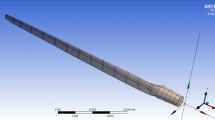Abstract
The effect of turbulence models on predicting the aerodynamic performance of horizontal-axis wind turbine (HAWT) rotor blades has been investigated. The flow fields around the 2-D airfoil and the 3-D blade of the NREL phase VI wind turbine rotor have been analyzed, and the results are compared between a correlation-based transition model and two other fully turbulent models. The turbulence models selected are the Spalart-Allmaras fully turbulent one-equation model, the k-ω SST fully turbulent two-equation model, and the  transition model. A vertex-centered finite-volume method based on an unstructured mesh technique was used to discretize the governing Navier-Stokes equations. The inviscid fluxes were calculated by using 2nd order Roe’s FDS, and the viscous fluxes were evaluated in a central-differencing manner. For the time integration, an implicit method based on the Gauss-Seidel iteration was used. The results showed that the
transition model. A vertex-centered finite-volume method based on an unstructured mesh technique was used to discretize the governing Navier-Stokes equations. The inviscid fluxes were calculated by using 2nd order Roe’s FDS, and the viscous fluxes were evaluated in a central-differencing manner. For the time integration, an implicit method based on the Gauss-Seidel iteration was used. The results showed that the  transition model well captures the laminar separation bubbles on the surface of the airfoil and the blade, and these separation bubbles trigger the separation-induced transition as the laminar flow separates and re-attaches as turbulent. The separation bubbles change the flow pattern on the surface of the airfoil and on the blade, and the pressure and skin-friction distributions are also changed abruptly across the laminar-turbulent transition. With properly predicted boundary-layer transition, the results of the
transition model well captures the laminar separation bubbles on the surface of the airfoil and the blade, and these separation bubbles trigger the separation-induced transition as the laminar flow separates and re-attaches as turbulent. The separation bubbles change the flow pattern on the surface of the airfoil and on the blade, and the pressure and skin-friction distributions are also changed abruptly across the laminar-turbulent transition. With properly predicted boundary-layer transition, the results of the  transition model match well with the experiment. However, the results of the fully turbulent models deviate from the experiment due to the lack of the ability of capturing the boundary-layer transition. The adoption of a proper transition turbulence model is essential for the accurate prediction of the aerodynamic loads and also the rotor performance for horizontal-axis wind turbines.
transition model match well with the experiment. However, the results of the fully turbulent models deviate from the experiment due to the lack of the ability of capturing the boundary-layer transition. The adoption of a proper transition turbulence model is essential for the accurate prediction of the aerodynamic loads and also the rotor performance for horizontal-axis wind turbines.
Similar content being viewed by others
References
D. M. Somers, Design and experimental results for the S809 airfoil, NREL/SR-440-6918, NREL (1997).
M. M. Hand, D. A. Simms, L. J. Fingersh, D. W. Jager, J. R. Cotrell, S. Schreck and S. M. Larwood, Unsteady aerodynamics experiment phase VI: wind tunnel test configurations and available data campaigns, NREL/TP-500-29955, NREL (2001).
R. B. Langtry, A correlation-based transition model using local variables for unstructured parallelized CFD codes, Ph.D. Dissertation, Institute of Thermal Turbomachinery and Machinery Lab., Univ. of Stuttgart, Stuttgart, Germany (2006).
R. B. Langtry and F. R. Menter, A correlation-based transition modeling for unstructured parallelized computational fluid dynamics codes, AIAA Journal, 47 (2009) 2894–2906.
J. Johansen, N. N. Sorensen, J. A. Michelsen and S. Schreck, Detached-eddy simulation of flow around the NREL phase VI blade, Wind Energy, 5 (2002) 185–197.
N. N. Sorensen, CFD modelling of laminar-turbulent transition for airfoils and rotors using the
 model, Wind Energy, 12 (2009) 715–733.
model, Wind Energy, 12 (2009) 715–733.M. A. Potsdam and D. J. Mavriplis, Unstructured mesh CFD aerodynamic analysis of the NREL phase VI rotor, 47 th AIAA Aerospace Science Meeting, Orlando, USA (2009).
A. M. O. Smith and N. Gamberoni, Transition, pressure gradient and stability theory, Calif. Rep. ES26388, Douglas Aircraft Company (1956).
R. E. Mayle, The role of laminar-turbulent transition in gas turbine engines, Journal of Turbomachinery, 113 (1991) 509–537.
B. J. Abu-Ghannam and R. Shaw, Natural transition of boundary layers — the effects of turbulence, pressure gradient, and flow history, Journal of Mechanical engineering Science, 22 (1980) 213–228.
P. R. Spalart and S. R. Allmaras, A one-equation turbulence model for aerodynamic flows, 30 th AIAA Aerospace Science Meeting, Reno, USA (1992).
F. R. Menter, Two-equation eddy viscosity turbulence models for engineering applications, AIAA Journal, 32 (1994) 1598–1605.
Author information
Authors and Affiliations
Corresponding author
Additional information
Recommended by Associate Editor Yang Na
Ju Yeol You is a Ph.D. student at the Computational Aerodynamics and Design Optimization Laboratory in the Department of Aerospace Engineering, KAIST, Korea. His research interests are hybrid RANS/LES and turbulence modeling.
Dong Ok Yu is a Ph.D. student at the Computational Aerodynamics and Design Optimization Laboratory in the Department of Aerospace Engineering, KAIST, Korea. His research interests are CFD-CSD coupling and rotor systems.
Oh Joon Kwon is a Professor in the Department of Aerospace Engineering, KAIST, Korea. His research interests are CFD based on unstructured mesh technique, design optimization, and rotor aerodynamics.
Rights and permissions
About this article
Cite this article
You, J.Y., Yu, D.O. & Kwon, O.J. Effect of turbulence models on predicting HAWT rotor blade performances. J Mech Sci Technol 27, 3703–3711 (2013). https://doi.org/10.1007/s12206-013-0916-y
Received:
Revised:
Accepted:
Published:
Issue Date:
DOI: https://doi.org/10.1007/s12206-013-0916-y





 model, Wind Energy, 12 (2009) 715–733.
model, Wind Energy, 12 (2009) 715–733.